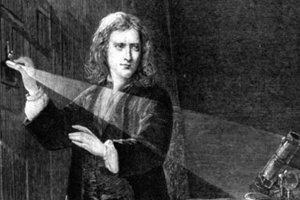Introduction
Known for the law of Gravity and three principles of Motion, Issac Newton revolutionized the way science and humanities were seen in Europe. His theories also impacted in furthering the cause of enlightenment in a great way. Enlightenment was a period in Europe where scientific discoveries were dominating over religious knowledge and education. Newton has many books to his credit, but his most popular one “Principia” was a landmark work that established his early theories of motion and gravity. Newton was also given the fame of serving as president of the popular Royal Society of London and master of the Royal Mint of England until he died in 1727.
Childhood and Education
Born on 4th January 1643, in Lincolnshire, England, Newton was the only son to a rich and prosper farmer who died before 3 months Isaac was born. His mother would later marry another man and baby Isaac would spend most of his time with his grandmother. Newton was born premature and doctors had little hope of him surviving that phase.
The family wanted him to be a farmer and continued the farming just like his father did. But, Isaac had different plans and he applied and got through the Trinity College at the University of Cambridge, where he studied classical curriculum. Fascinated by modern political philosophers like Descartes, Copernicus, Galileo, and Kepler.
After the great plague happened in 1665, Newton returned home and began forming theories on light, color, and calculus. It is here that the popular apple falling from tree and him being inquisitive about it would happen and later the rest of the story of him discovering Gravity will follow up.
Telescope, Light, and Law of Gravity
After returning to Cambridge in 1667, Newton constructed the first reflecting telescope a year later and received his Masters of Arts degree the following year. Royal Society of London would ask him to demonstrate the mechanics of his telescope which would help him in being elected in the society.
His experiments with the refraction of light will compel him to argue that the white light was a composite of all the colors on the spectrum and instead of waves, the light was actually made of particles. His theory drew criticism from the Royal Society of London. Robert Hooke and he engaged in a heated argument which led to Newton encountering a nervous breakdown. He withdrew from the public eye for some years and focused on working on the elements of gravity.
After English astronomer, Halley found out that Newton had sorted out the elliptical paths of celestial bodies, he paid him a visit and asked him to organize his notes. It resulted in Newton writing, Mathematical Principles of Natural Philosophy that established the popular three laws of motion:
- Every object that is in the state of a uniform motion shall remain in that state of motion until an external force acts upon it
- Force is equal to Mass times Acceleration: F=MA
- For every single action, there will be an equal and opposite reaction.
Contributions and last days
Newton’s works and emphasis on the scientific temper laid the foundation of Enlightenment in Europe. He was also a distinguished scholar of religious books and doctrines. His works were later combined and printed after his death. Having never married, he spent his last years in Cranbury Park. Newton died in his sleep and was buried at Westminster Abbey.
Inspiring not just his generation, he also gave way for future great minds to think on something extraordinary. Albert Einstein was also motivated by Newton’s works and furthered his research, eventually, his theories of space and time served as the bedrock on which modern physics was built.
FAQ
Which is the most popular book by Isaac Newton?
Newton has many books to his credit, but his most popular one “Principia” was a landmark work that established his early theories of motion and gravity.
When did Newton construct the first reflecting telescope?
After returning to Cambridge in 1667, Newton constructed the first reflecting telescope a year later and received his Masters of Arts degree the following year. Royal Society of London would ask him to demonstrate the mechanics of his telescope which would help him in being elected in the society.
What happened after Newton wrote Mathematical Principles of Natural Philosophy?
Mathematical Principles of Natural Philosophy established the popular three laws of motion: -Every object that is in the state of a uniform motion shall remain in that state of motion until an external force acts upon it -Force is equal to Mass times Acceleration: F=MA -For every single action, there will be an equal and opposite reaction.




